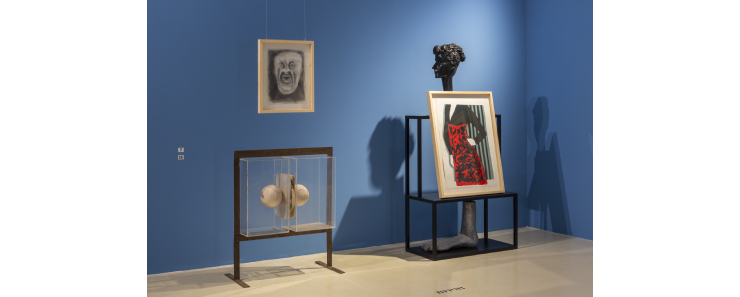
Through a pair of eyes, through windows, or through a gateway to another world – we peer into the room. With two eyes we see the world twice, from two different points of view, simultaneously. With eyes situated at the front of the head, side by side, as in humans, the two fields of view are adjacent, and an overlap forms between them. In this manner, with each eye seeing the same image as the adjoining eye but from a slightly different angle, a perception of depth is created. Thus, one can see elements such as a room, a sculpture, or a window, as three-dimensional. The gazelle, however, differs from us. Had it found itself in a museum, it could have gazed at the art pieces on either side of it at the same time, because its eyes are situated on either side of its head and point in opposite directions – one to the right, and the other to the left. In nature, the gazelle can see everything around it. But in the absence of overlapping fields of vision, it sees a flat picture, like a painting. In this exhibition, various encounters are created – between painting and sculpture; print and photography; human and animal; head and body; living, inanimate, and landscape – that make it possible to imagine impossible connections between different types of vision.
The exhibition was curated by twelve boys and girls, aged nine to eleven, who met throughout the year at MUZA, the Educational Wing of the Herzliya Museum of Contemporary Art, as part of its Young Curators project. Now in its second iteration, the project is a collaborative venture of the museum’s team of curators and its educational staff. The exhibition emerged in the course of a weekly workshop, in which the children rose to the challenge of curating an exhibition from the museum’s collection. The curatorial decisions were made by the children through consensus, while performing exercises and playing games designed to foster an in-depth examination of the art pieces and their interrelationships.
The encounters with the children compelled the project team to examine curating itself as a practice, outside the professional milieu. The educational process meant breaking down the curatorial process into primary building blocks, and we, as curators, had to re-examine how we decide what to exhibit at the museum. In addition, working with the children made it possible to deviate from our usual ambit as experienced curators, and to create challenging, bizarre, or surprising links between the exhibited works.
The exhibition is supported by the Friends of the Museum: Yael and Shabtai Shavit, and anonymous friends; and by Hapoalim Community Fund, Bank Hapoalim.
Less Reading...

